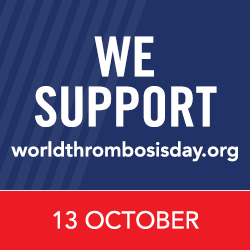Protect Yourself from Blood Clots
 If you are currently or recently hospitalized, recovering from surgery, or being treated for cancer, you are at increased risk of developing serious and potentially deadly blood clots. This condition, called healthcare-associated venous thromboembolism (HA-VTE), is a deadly, costly, and growing public health problem. Learn what you can do to protect yourself.
If you are currently or recently hospitalized, recovering from surgery, or being treated for cancer, you are at increased risk of developing serious and potentially deadly blood clots. This condition, called healthcare-associated venous thromboembolism (HA-VTE), is a deadly, costly, and growing public health problem. Learn what you can do to protect yourself.
Deep vein thrombosis (DVT) is a blood clot in a large vein, usually in the leg or pelvis. A DVT can break free from where it formed and move through the bloodstream. If the clot moves through the heart to the lungs it can block an artery supplying blood to the lungs. This condition is called pulmonary embolism (PE) which can be fatal. DVT and PE, together, are known as venous thromboembolism (VTE). VTE is a major public health problem, with hundreds of thousands of people affected each year. Almost half of all blood clots are healthcare-associated (HA-VTE) — that is, they occur during or soon after surgery or a stay in a hospital or healthcare setting. But HA-VTE can be prevented.
People can develop a blood clot for a variety of reasons. However, having surgery or being a patient in the hospital increases your risk for developing a blood clot. Also, many blood clots don’t occur until after discharge from the hospital. Therefore it is important to know what you can do to minimize the risk of HA-VTE.

Before surgery or hospitalization: Ask your healthcare provider if you are at risk for blood clots and whether you need preventive treatment.

October 13 marks World Thrombosis Day , a day devoted to the global movement to prevent blood clots. CDC supports World Thrombosis Day and this year’s theme is HA-VTE.
Prevention Can Save Lives
Here are some tips to help you protect yourself if you are planning a hospital stay or a procedure in a healthcare setting:
Before surgery or hospitalization: Ask your healthcare provider if you are at risk for blood clots and whether you need preventive treatment.
Upon discharge: Ask your healthcare team the following questions:
- What can I do to continue to prevent blood clots once I am at home?
- What are the signs and symptoms of a blood clot?
- What do I need to do if I think I have a blood clot?
At home:
- Follow your doctor’s instructions and take medicines as prescribed.
- Move your arms and legs to help prevent blood clots from forming.
- Call your doctor if you think you have a blood clot.
What CDC is Doing About HA-VTE?
- CDC has funded two pilot programs at Duke University and the University of Oklahoma Health Sciences Center to develop and evaluate methods to identify and monitor VTE occurring in the community (including those that are healthcare-associated). The lessons learned from these two projects will provide the needed foundation to guide and evaluate strategies to prevent VTE.
- CDC is collaborating with the Joint Commission’s Center for Transforming Healthcare to identify the root causes and barriers to preventing VTE in at-risk patients. Five participating hospitals and health centers will utilize a problem-solving methodology to develop solutions that are targeted to the specific root causes for VTE among their patients. Solutions will then be tested, validated, and spread to other organizations.
- CDC is launching a Healthcare-Associated Venous Thromboembolism Prevention Challenge in November 2015. The challenge will showcase organizations that:
- invest in VTE prevention,
- improve understanding of successful implementation strategies at the health systems level, and motivate health systems to strengthen their VTE prevention efforts.
The top-judged organizations found to have implemented innovative and effective VTE prevention strategies will be recognized as HA-VTE Prevention Champions.
- CDC provides funding to support health education, training, and health promotion programs on blood clots:
National Blood Clot Alliance (NBCA)
CDC has worked with NBCA to develop a national public health awareness campaign to get the word out about blood clots. The campaign is called Stop the Clot TM – Spread the Word. This new campaign includes:- an online educational portal that offers a downloadable checklist of blood clot risk factors,
- a short video about blood clots, and
- additional information to help people learn more about risks, signs, symptoms, and blood clot prevention measures.
CDC has also funded NBCA to develop an online curriculum for healthcare professionals called Stop the Clot: What Every Healthcare Professional Should Know. This self-paced, online course provides the most current foundational information and clinical considerations to assess, treat, and manage patients who have blood clots.
Duke Hemostasis and Thrombosis Center
CDC funded Duke to complete work on the This Is Serious campaign. This campaign, developed in partnership with CDC and the Spirit of Women® hospital network, was designed to drive awareness and action around the prevention of blood clots in women. Topics addressed include pregnancy, surgery and trauma, and cancer.
Signs and Symptoms of Blood Clots
DVT
About half of people with DVT have no symptoms at all. The following are the most common symptoms of DVT that occur in the affected part of the body, often the leg or arm:
- Swelling
- Pain
- Tenderness
- Redness of the skin
If you have any of these symptoms, see your doctor as soon as possible.
PE
You can have a PE without any symptoms of a DVT.
Signs and symptoms of PE can include:
- Difficulty breathing
- Faster than normal or irregular heart beat
- Chest pain or discomfort, which usually worsens with a deep breath or coughing
- Coughing up blood
- Very low blood pressure, lightheadedness, or fainting
- Page last reviewed: October 13, 2015
- Page last updated: October 13, 2015
- Content source:
- National Center on Birth Defects and Developmental Disabilities, Division of Blood Disorders
- Page maintained by: Office of the Associate Director for Communication, Digital Media Branch, Division of Public Affairs




 ShareCompartir
ShareCompartir